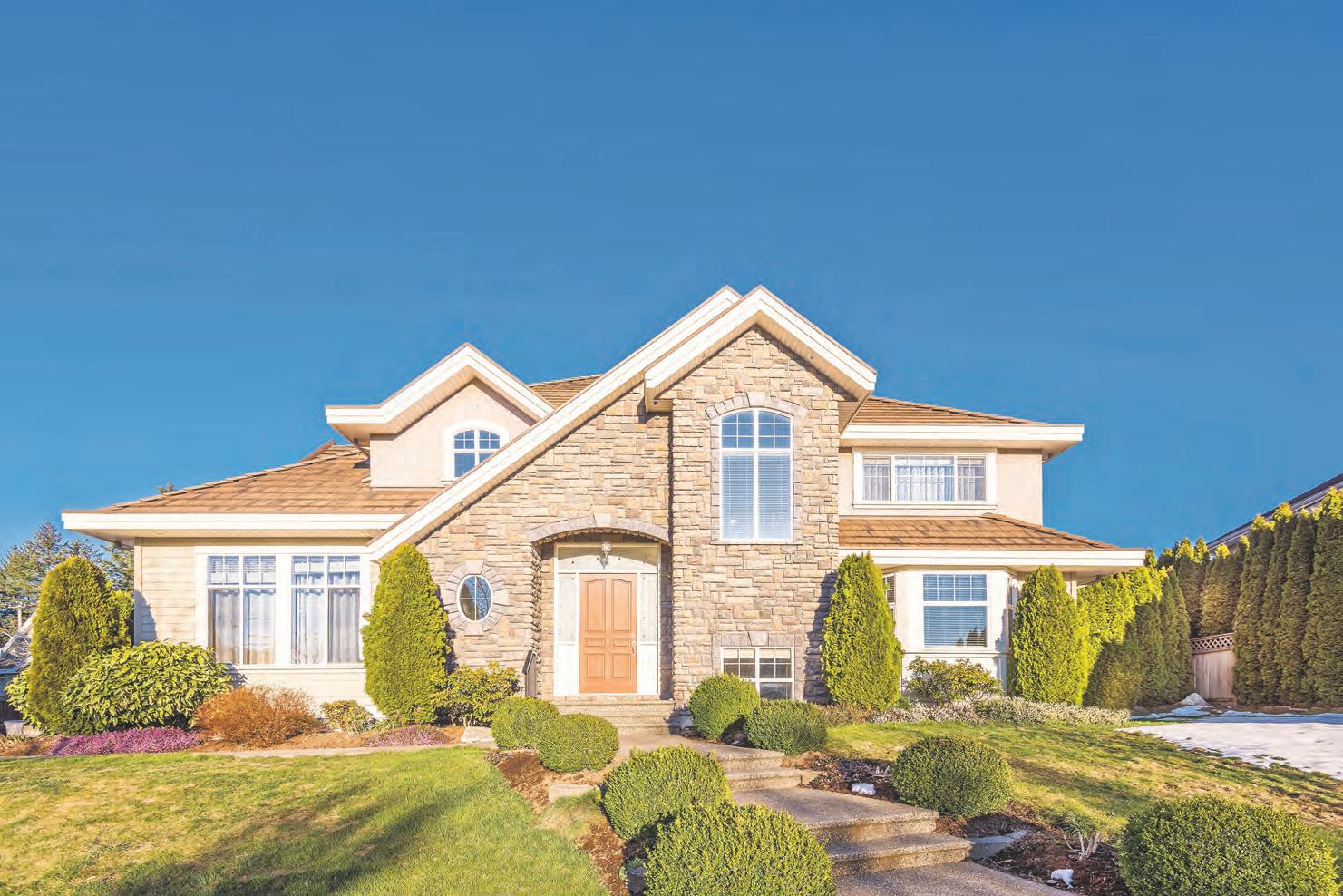







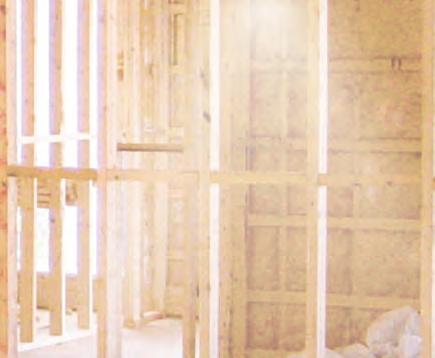
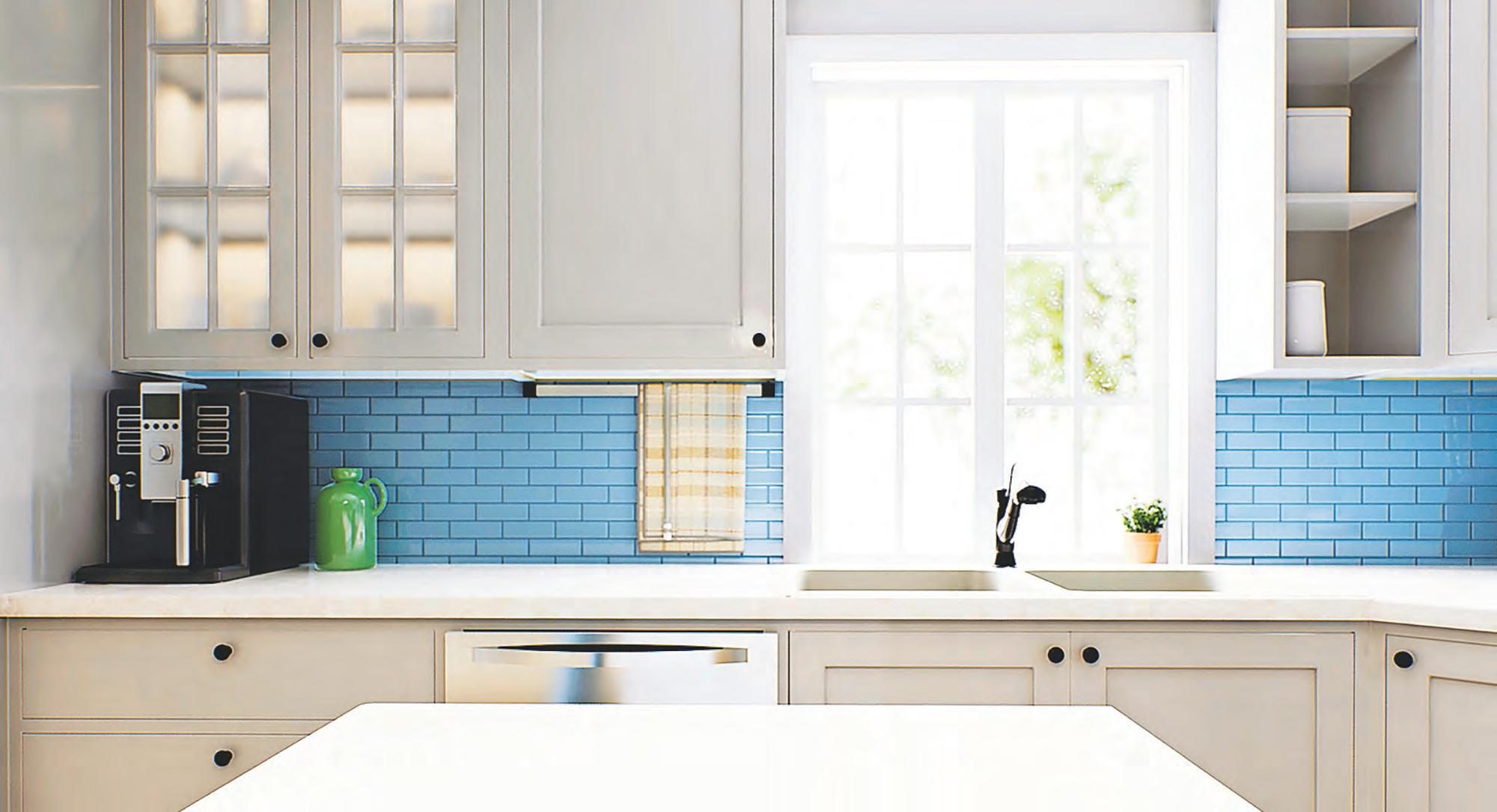











ainting ceramic tiles is a costeffective way to refresh the look of your kitchen or bathroom without the expense of replacing the tiles. Here are four steps to guide you through the process.
1Prepare the tiles. Clean the tiles thoroughly with a degreaser or a mixture of water and a mild detergent. Touch up any imperfections in the tiles and grout, and then sand away the ceramic glazing. Allow the tiles to dry completely.
2Apply a primer. Use a primer specifically designed for ceramic tiles. Apply the primer evenly to all the tiles, including the grout lines. Allow the primer to dry completely.
3Paint the tiles. Choose a paint that’s specifically designed for ceramic tiles. Apply a thin and even coat of paint to all the tiles. Use a paintbrush to paint around the edges of the tiles and a roller to paint the larger areas. Allow each coat to dry completely before applying the next coat.
4Seal the tiles. Once the paint is dry, apply a sealant to protect it from wear and tear.
Be patient and take your time. Painting ceramic tiles can be a bit of a challenge, but it’s possible to do it yourself. Visit your local home improvement store to get started.
As the weather warms up, many insects and animals come out of hiding, looking for a place to live or raise their young.
Pests to look out for in spring include small mammals like skunks, groundhogs, raccoons, squirrels and mice. These small but mighty critters can cause damage to your home and yard.
Birds, such as swallows and sparrows, can also build nests in inconvenient places, such as your eavestroughs or attic. During the spring thaw, ants, wasps and other insects can also become an issue.
Depending on the species involved, pest infestations can lead to various consequences. Some risks include:
• Structural damage
• Fires
• Contaminated food
• Allergic reactions to insect bites
• Animal-related diseases
You can do several things to prevent a pest infestation, including keeping the inside of your home clean, regularly emptying the trash, storing food in airtight containers, repairing cracks, replacing damaged weatherstrip, placing screens over vents and trimming overhanging tree branches. Additionally, it’s a good idea to trim overgrown bushes or hedges to eliminate nesting places for rodents.
If pests are still getting into your home despite your best efforts, call a local pest control expert to address the issue. Professionals can quickly and effectively relocate troublesome animals and exterminate unwanted insects.







NEWSPAPER TOOLBOX
If you need a small wiring job done in your home, you may be tempted to go the DIY route. However, electrical work is complex and potentially dangerous, so hiring a professional is the better option. Here are five reasons to always opt for a certified electrician.
1Safety. Working with electricity is hazardous, but a certified electrician has the training and experience to work on your electrical system safely and correctly.
2Code compliance. A certified electrician has the skills and experience to get the job done right. They’ll follow the latest electrical codes and standards and can troubleshoot any problems that may arise.
3Peace of mind. Hiring a certified electrician can give you peace of mind that the job will be done correctly and safely. You won’t have to worry about making a mistake that could cause a fire.
4Guarantee. Many certified electricians offer a guarantee on their work. With a typical guarantee, if you’re not satisfied with the work or something goes wrong, they’ll come back and fix it at no charge.
5Cost savings. In the long run, it’s more costeffective to hire a certified electrician because they’ll do the job correctly the first time, preventing costly repairs down the road. Look for a certified electrician near you to ensure your renovations are done right.




Winter might not be the first season that comes to mind when you think about using a dehumidifier. However, there are several compelling reasons to consider incorporating a dehumidifier into your home to control humidity levels during the winter months. Here are four.
1Combat condensation. During winter, temperature differences between the warm indoors and the cold outdoors can lead to condensation on windows and walls. Dehumidifiers help reduce this excess moisture, preventing potential damage to your home.
2Protect your health. Excessive indoor moisture can create a breeding ground for mold and mildew. These pollutants can exacerbate respiratory problems and allergies. Additionally, too much moisture can lead to severe health issues like coughing, dizziness, headaches and sinus congestion. Controlling humidity levels with a dehumidifier can help your family stay healthy.
3Preserve your belongings. High humidity can damage your belongings, including books, clothing, musical instruments and electronics. Using a dehumidifier in winter can protect your valuables from excess moisture and potential deterioration.
4Improved air quality. A dehumidifier cleans and removes moisture from stale indoor air. The unit then circulates the clean air back into your home. You’ll enjoy improved air quality as you breathe in fresher-feeling air.
Regularly maintain and clean your dehumidifier to prevent mold and bacteria growth. Visit your local HVAC company or home improvement store to look for a dehumidifier for your home.
Give us a call for all your construction needs.


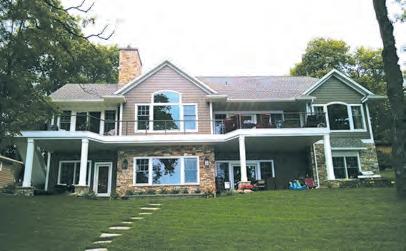
When it comes to choosing an eco-friendly siding solution for your home, a wide array of environmentally responsible options is available. These sustainable choices reduce your carbon footprint and offer durability and aesthetic appeal. Here’s a breakdown of some popular eco-friendly siding materials:
1Eco-friendly wood. Wood siding adds a natural, rustic charm to your home. When shopping, look for wood siding with the Forest Stewardship Council (FSC) logo. This certifies that the product comes from a responsibly managed forest.
2Sustainable bricks. More and more “ecological” bricks are being introduced to the market.
These bricks are often made from compressed raw earth, recycled glass or hemp. They require less energy to manufacture than traditional bricks.
3Recycled metal. Metal siding, particularly when made from recycled materials, is a durable and low-maintenance option. It can be recycled again at the end of its lifespan, reducing waste.
4Local natural stone. If you’re looking for durable cladding that offers timeless elegance, consider using natural stone. However, make sure you buy from a local supplier! Each of these eco-friendly siding materials offers unique benefits, from aesthetics to insulative properties. When considering an upgrade, ask a professional for advice.















Whether you need a new heating system, heating maintenance or repair, Magnuson Sheet Metal is the company you can trust to do the job right.
Our technicians will use the latest technology to diagnose and repair your air conditioning issues, so you’re comfortable again as soon as possible.
As a custom sheet metal fabrication company, Magnuson Sheet Metal offers custom ductwork and other sheet metal parts to builders, businesses and homeowners.
Let Magnuson Sheet Metal provide you with a complete indoor air quality check of your home and the right solution to overcome indoor air pollution.


When choosing new window treatments for your home, consider upgrading to motorized blinds and curtains. These innovative coverings offer numerous benefits.
• They’re convenient. You can easily adjust the position of your window coverings with the push of a button. They allow you to control natural light, privacy and room ambiance effortlessly. Open or close them all at once or customize settings for individual windows.
• They’re smart. Many motorized systems can be integrated with smart home platforms like Alexa or Google Home, enabling voice-activated control or scheduled adjustments. You can also open or close your blinds from anywhere and at any time using your smartphone.


• They’re safe. Motorized blinds and curtains eliminate the need for traditional cords and chains, an excellent safety feature in homes with children or pets. You reduce the risk of accidents and enjoy more peace of mind.
• They improve efficiency. Programming blinds and curtains to open or close at specific times of the day helps regulate indoor temperatures. Closing blinds on hot summer days blocks out the sun’s heat, reducing the need for air conditioning. This energy-efficient approach can lower your utility bills and reduce your environmental impact.
Visit your local home improvement store or window covering retailer to find the perfect set of motorized blinds and curtains for your home.






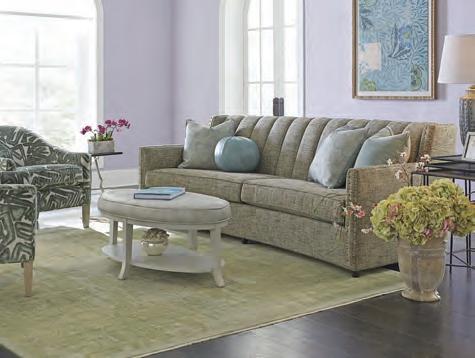






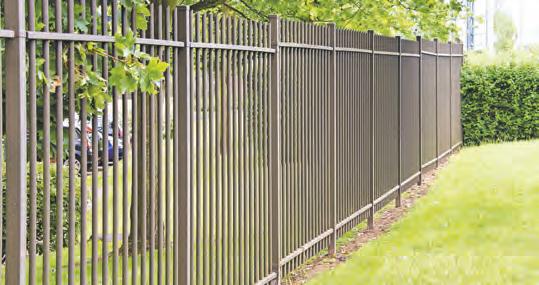
NEWSPAPER TOOLBOX
Choosing the best fence for your property can be challenging, with numerous materials and styles to choose from. To help you decide, here are some common types of fences, plus tips on selecting the right one.
1 Wood fences are popular for their natural beauty and durability. A wood fence can be stained or painted to match
your home’s exterior, and you can customize it to fit your specific needs. However, wood requires some maintenance.
2 Chain-link fences are more affordable than wood fences. They’re also durable and can withstand a lot of wear and tear. Chain-link fences aren’t as esthetically pleasing as other fences, but they’re a good choice for security.
3Vinyl fences are low-maintenance and resistant to rot and decay. They come in a variety of colors and styles, so you can find one to complement the style and color scheme of your home’s exterior. Vinyl fences are also relatively easy to install.
4Metal fences are often used for security purposes, such as around schools or businesses. Metal fences can be made from a variety of
materials, including wrought iron, steel and aluminum.
When fence shopping, consider your practical needs and budget and choose a style that suits your property. Ask a professional for advice on the right material, height and design to meet your objectives while adhering to zoning regulations and property boundaries.
Interior design is a tool for selfexpression and a way to convey your personal story, values and experiences. Here are six ideas to help you tell your unique story through your home’s interior design.
1Personal art and collections. Showcase your personality and interests by displaying personal art, photographs or collections.
2Colors. Choose a color scheme that resonates with your emotions and experiences. Warm, earthy tones can create a cozy, welcoming atmosphere, while vibrant colors can express energy and creativity.
3Texture and materials. Incorporate textures and materials that reflect your lifestyle and experiences. Natural wood and stone convey a connection to nature. Metallic accents can suggest
modernity and sophistication.
4Customization. Furniture, handcrafted pieces or personalized wall art can be tailored to your tastes and experiences, making them meaningful additions to your home.
5Storytelling décor. This could be a vintage map representing your travels, a bookshelf filled with your favorite reads or a tapestry from a place that holds sentimental value. These elements can serve as visual storytelling devices.
6Personalized spaces. Dedicate specific areas of your home to different aspects of your life. Create a reading nook, a meditation corner or a hobby space that speaks to your interests and passions.
Visit your local stores for inspiration and enlist the help of an interior designer for more great ideas.
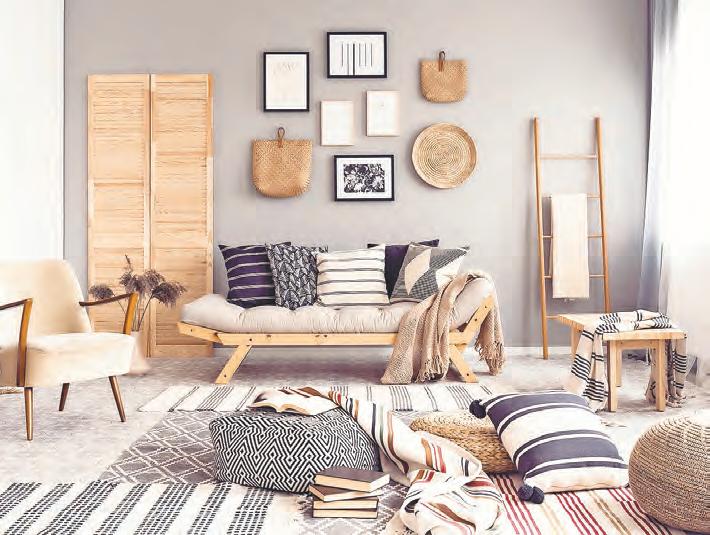








Dual-energy systems combine two sources of energy for heating and cooling, typically a high-efficiency electric heat pump and a backup running on natural gas or propane. Here are five benefits of dual-energy systems:
1Energy efficiency. Dual-energy systems offer enhanced efficiency by utilizing the heat pump’s mode during moderate weather conditions. This reduces energy consumption and lowers utility bills.
2Environmental sustainability. Dual-energy systems reduce greenhouse gas emissions. Heat pumps use electricity more efficiently than traditional heating systems, especially in regions with a clean energy grid.
3Reliability. The backup heating system ensures heating and cooling reliability during extreme weather when the heat pump is less efficient or when the electricity supply is unstable.
4Cost savings. Some regional governments and utility companies incentivize consumers to adopt energy-efficient heating systems. Besides reduced energy bills, homeowners may benefit from rebates and tax credits.
5Versatility. Dual-energy systems can be adapted to changing climate conditions because they can efficiently handle both heating and cooling needs.
Are you ready to switch to a sustainable dual-energy system for your home? Contact your local HVAC company and ask about heat pump installation and the potential rebates you may be eligible for.






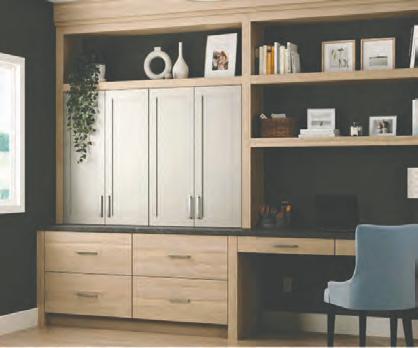


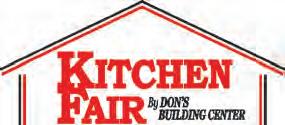
Is your toilet showing its age? Are you thinking about investing in a new one? Are you renovating your bathroom and want to update this essential fixture? Beyond aesthetic considerations, here are some telltale signs it might be time for a new commode:
• The toilet leaks or is frequently clogged.
• The flush mechanism works erratically despite attempts at repairing it.
• There are cracks in the porcelain bowl or tank.
• The water tank runs continuously.
• The toilet is unstable and moves when you sit on it.
• The seat is uncomfortable. Modern models feature elongated bowls, which provide more support and comfort than round seats.
• The plumber visits so often that you’ve become friends.
If your toilet is past its prime, you may want to consider swapping it for a low-flow model to reduce your water consumption. Has your water bill recently increased? A faulty toilet could be to blame. It may be wise and cost-effective to replace it.

When shopping for a new toilet, it’s essential to consider the size and shape of the bowl, as well as the rough-in distance, to ensure you make the right choice.


Investing in regular professional heat pump maintenance is a proactive step toward ensuring the comfort and well-being of your home’s occupants. Here are the key advantages.
1 Enhanced energy efficiency. Professional maintenance ensures your heat pump operates at peak efficiency. This reduces energy consumption, lowers utility bills and minimizes your carbon footprint.
2 Extended lifespan. Regular inspections and tune-ups help identify and address potential issues early, preventing costly breakdowns and extending the lifespan of your heat pump.
3 Improved comfort. Wellmaintained heat pumps provide consistent and reliable heating and cooling, creating a more comfortable indoor environment for you and your family.
4 Better air quality. Having a professional clean and replace your heat pump’s filters ensures proper airflow and helps maintain good indoor air quality by reducing dust, allergens and pollutants from circulating in your home.
5 Peace of mind. Regular maintenance provides peace of mind. You can rest easy knowing your heat pump is in top working condition.
Contact a local HVAC professional to perform preventative maintenance on your heat pump system to enjoy worry-free indoor comfort all year round.




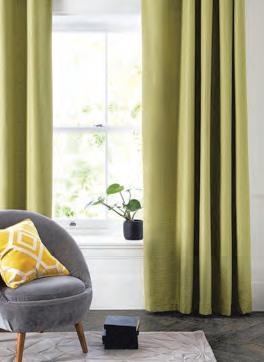

Every spring, it’s a good idea to inspect your roof to see if it withstood the winter months. This will help you identify any problems and take necessary action. Here’s what you need to know when doing a thorough visual inspection of your roof.
Climbing onto your roof can be risky, so use appropriate safety equipment, including closed-toe, non-slip shoes, a sturdy ladder and a safety harness. Having someone help you stabilize the ladder and be available in an emergency is also a good idea.
Additionally, ensure the roof is dry before inspecting it. Choose a day with minimal wind and cool temperatures to avoid working on a screaming hot surface.
First, remove any debris, such as
leaves. Then, inspect all accessible parts of the roof to identify problems such as:
• Standing water
• A damaged or deformed membrane
• An uneven gravel layer
• Cracked sealing joints
• Rusted or flimsy flashing
• Protruding nails
• Missing, broken or lifted shingles
• Mold
It’s also a good idea to examine your attic, walls and ceilings while you’re at it. Check for signs of water infiltration or poor ventilation. Unpleasant odors, mold, excessive moisture and peeling paint are telltale signs that something’s amiss.
If you notice an issue, don’t wait for it to worsen. Seek professional help. If you’re uncomfortable inspecting your roof, call a local roofing professional to get the most accurate assessment of your roof’s condition.


too!
Are you building or upgrading your home and looking to minimize your impact on the environment? Consider glued laminated wood — or glulam. Here’s what you need to know about this sustainable and eco-friendly product.
Valued for its structural strength, versatility and sustainability, glulam is made by bonding together layers of lumber with strong adhesives. It’s often used in construction for beams, columns and other load-bearing elements.
Here are a few ways glulam is an environmentally responsible choice:
• Sustainable sourcing. Glued laminated wood is made from sustainably sourced timber. The timber used for glulam beams and columns
often comes from forests managed with responsible forestry practices. By choosing glulam, you contribute to the preservation of forests and reduce the demand for non-renewable construction materials.
• Reduced carbon footprint. Manufacturing glulam consumes less energy and emits fewer greenhouse gases than concrete or steel production. Additionally, wood stores carbon dioxide from the atmosphere for the life of the structure, making glulam an effective way to sequester carbon and combat climate change.
• Energy efficiency. Glulam has excellent insulation properties. Its natural thermal resistance helps regulate indoor temperatures, reducing the need for energy-burning heating and cooling. Ask your local contractor about glulam for your next construction project.
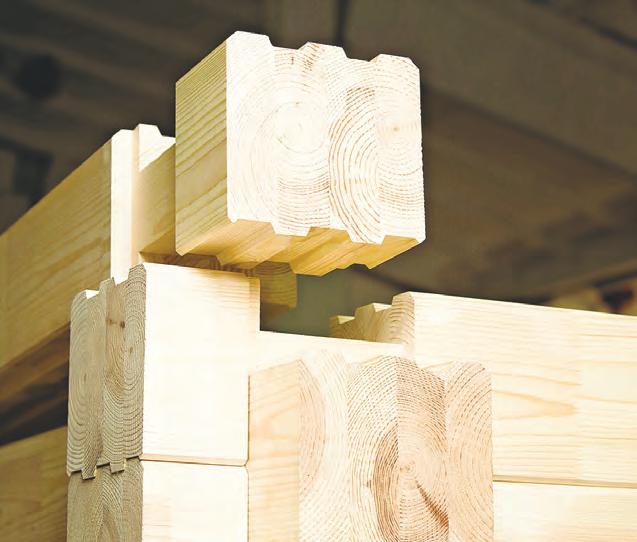
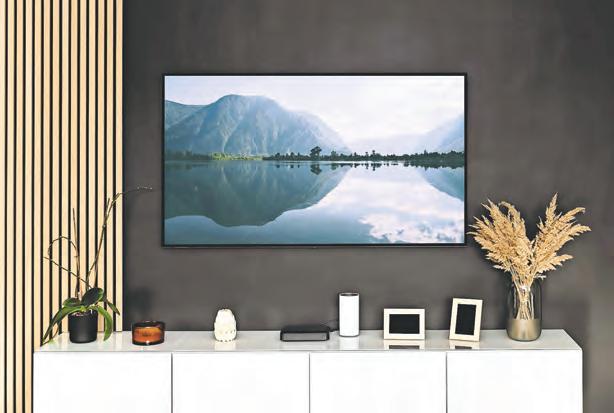
Are you redecorating your living room? Do you want to take the focus off your bigscreen TV? Here are a few creative ways to hide your TV within your decor.
1
Hide it behind doors or panels. If you want to physically cover your TV, you could opt for a custom-made cabinet, a DIY textured sliding panel or stylish barn doors. This is also a great solution if you have other items you want to tidy up, like a collection of DVDs or gaming consoles.
2
Invest in a smart picture TV.
Although a bit pricey, you can purchase a smart TV with a built-in frame that looks like a piece of art. When you aren’t watching the TV, you can switch to gallery mode to display beautiful photos and images.
3Surround it with a gallery wall. Blend your TV into the rest of your decor by surrounding it with variously sized, unevenly spaced framed photos and prints. This will help distract the eye and make the TV less of a focus. Plus, the gallery wall will make a statement and add interest and personality to your space.
4Buy a pop-up stand. You can purchase various styles of free-standing cabinets with a pop-up mechanism for your TV. The TV neatly tucks away to free up valuable wall space when you aren’t using it. Consult a local interior designer to help you choose the perfect option for your home.
NEWSPAPER TOOLBOX
Epoxy resin is a durable and versatile material that can be used to create various decorative pieces, including wall art, furniture and more. Here’s a look at some interesting ways to use epoxy resin in your décor.
1 Drink coasters. Add a touch of elegance to your coffee table with epoxy resin drink coasters. Consider preserving dried flowers or adding glitter for an extra touch of glam. You can also create geodeinspired designs within the resin.
2 Artwork. Unleash your creativity by using epoxy resin to make glossy, eye-catching artwork. Try experimenting with abstract designs, ocean waves, or even galaxy-inspired themes. You can also preserve your favorite photographs in resin to create unique wall art.
3Cutting board. Elevate your kitchen aesthetics by coating a wooden cutting board with epoxy resin. Not only will this protect the wood, but it will also add a personalized touch to your culinary space. Customize the colors and patterns to match your kitchen decor.
4Living room table. Turn an ordinary wooden table into an exquisite piece of art with epoxy resin. Pour the resin over live-edge wood surfaces to create mesmerizing patterns and colors. Your epoxy resin table is sure to be a showstopper in your living room.
5Breakfast/TV tray. Make your breakfast-in-bed or TV-watching experience more enjoyable with a personalized epoxy resin tray. These versatile trays can be customized to match your style.
Visit your local hardware store to find all the materials you need to make an epoxy resin work of art.
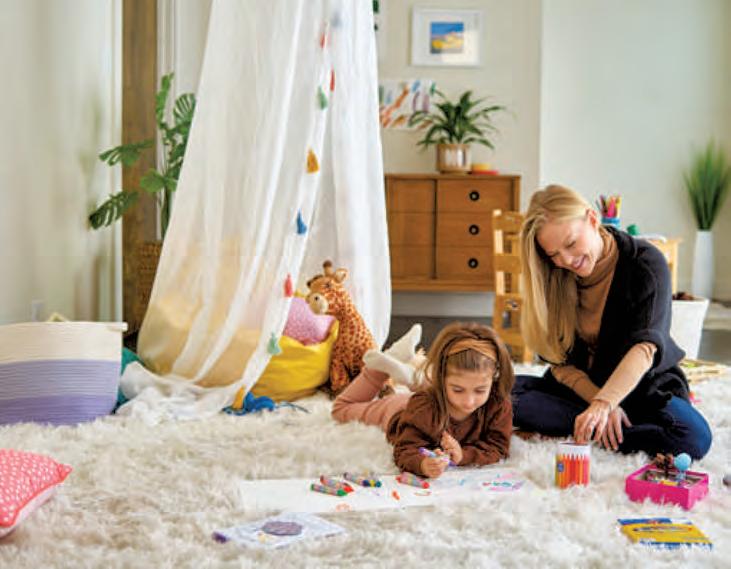

TODAY’S FORCAST:
THISWINTER’S FORECAST: WhateverMakes YouComfortable. Withsmarttemperaturemanagementand remote-accessoptions,newtechnologyfrom Carriermakesiteasierthanevertocontrol yourhome’sclimate.Carrier’senergyefficientsystemscanhelpreduceutilitybills withoutsacrificingcomfort.Formore completecontrolandgreaterpeaceofmind, turntotheexpertsatChappellCentral.
TOFINDTHESYSTEMTHAT’S RIGHTFORYOU,CONTACT CHAPPELLCENTRAL.







Ombre, a popular technique in interior design, involves creating visually striking effect through a gradual transition of colors, usually from light to dark. Used to add depth and dimension, it creates a sense of movement or vitality in the space. Here are three ways to incorporate ombre into your home decor.
• Ombre walls. Ombre wall treatments involve blending two or more colors to create a seamless gradient effect. Try painting the wall in a way that the colors transition from one hue to another, either vertically or horizontally. Ombre walls can make a room feel more dynamic, create a focal point or evoke a sense of serenity, depending on the chosen palette.
• Ombre linens. Ombre linens, such as curtains, bedspreads and tablecloths, can add a touch of sophistication and drama to a room. For instance, ombre curtains can filter light beautifully, and ombre bed linens can infuse a bedroom with a calming or energizing ambiance.
• Ombre furniture. The ombre technique can transform ordinary furniture into eye-catching focal points. By blending colors harmoniously, ombre furniture adds an artistic and contemporary flair to interior spaces.
Ombre offers a wide range of color options and applications and can bring a sense of esthetic harmony to any room. Look for ombre home decor items at your local retailers.

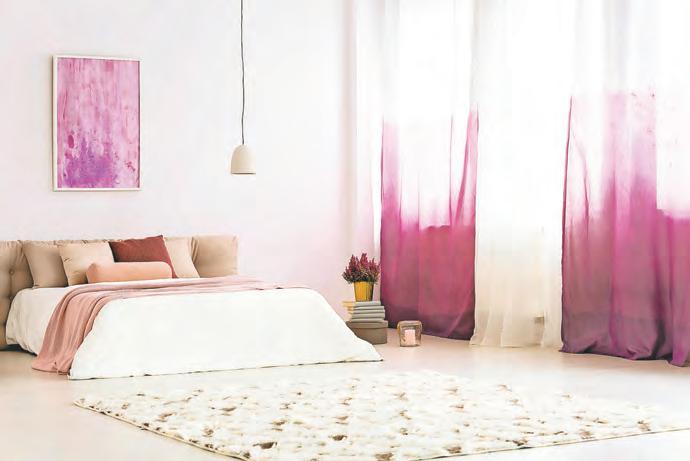

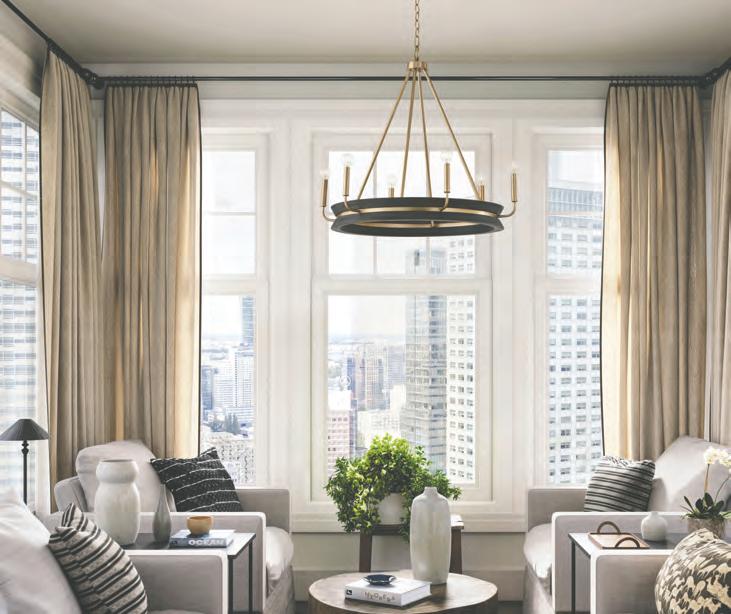


Insulation is an important part of any home. It helps reduce your energy costs by keeping your space warm in the winter and cool in the summer. However, traditional fiberglass insulation contains hazardous fibers, and its manufacturing process is highly energy-intensive. Here are three green insulation options to consider.
1Sheep’s wool. When sheep’s wool fibers are compressed, they form millions of tiny air pockets. These pockets trap air to keep your home at the perfect temperature all year round. Moreover, wool is breathable, so the material’s inner layer can absorb moisture without feeling damp or affecting its ability to retain heat.
2Cellulose. Cellulose insulation is made of recycled newsprint and other types of paper. It’s a dense product that provides high heat resistance. Plus, it’s treated with boric acid, making it fire-resistant.
3Cork. Cork insulation is made from the outer bark of oak trees and is natural, renewable, recyclable and biodegradable. Once produced, the finished product has a negative carbon footprint. Cork is also hypoallergic and has sound-deadening qualities.
Visit your local hardware store to explore insulation options for your home.



Natural materials are increasingly favored in home construction for their esthetic appeal, sustainability and durability. Here are five preferred natural materials.
1
Wood. A timeless choice due to its warm, inviting look and versatility, wood can be used for framing, flooring, cabinetry and more. It provides a rustic charm and contributes to a comfortable, cozy ambiance.
2
Quartz. Durable and elegant, quartz is often used for countertops and backsplashes in kitchens and bathrooms. It’s prized for its resistance to stains and scratches, making it beautiful and practical in high-traffic areas.
3
Stone. Natural stone, such as granite, marble and slate, adds a touch of luxury and durability to
countertops, flooring and fireplace surrounds. Stone is prized for the visual interest provided by its unique veining.
4Bamboo. Bamboo is a fast-growing, renewable resource known for its strength and versatility. It can be utilized for flooring, structural elements, and as a replacement for traditional timber. Bamboo cultivation typically requires minimal water, pesticides, and fertilizers.
5
Hemp. With robust fibers, hemp is an ideal choice for insulation, wall panels, and even building blocks. It’s biodegradable, non-toxic, and has excellent insulation properties. Hemp production also generates less pollution and waste compared to traditional materials.
Visit your local home improvement stores to find these beautiful natural products.

Biophilic design incorporates elements of the natural world into homes and businesses to foster a sense of tranquility and vitality. Urbanization is causing people to spend more time indoors, leading to disconnection from the natural world. Biophilic design aims to bridge this gap by bringing nature indoors.
Here are some examples of biophilic design elements:
• Visual details. Elements could include views of nature through large windows, indoor plants or artwork depicting nature.
• Non-visual elements. Auditory cues, such as birds chirping or a waterfall, or natural materials like wood or stone can bring nature to all the senses.
• Dynamic and diffuse light. Consider allowing natural light in whenever possible or using artificial lighting to create a similar effect.
• Connection with natural systems.


Incorporating living plants into a space or using sustainably harvested materials evoke that sense of connection.
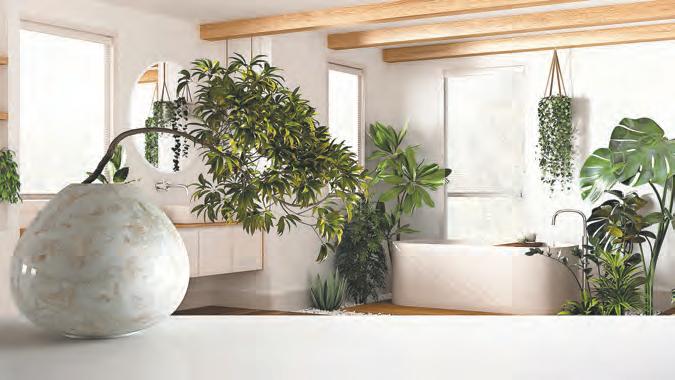
• Replicate natural shapes. This could include using natural patterns and shapes, such as curved lines or organic forms.
Studies have shown that biophilic design has several benefits for human health and well-being, including:
• Reduced stress and anxiety
• Improved mood and cognitive function
• Increased creativity and productivity
• Boosted immune system
• Reduced absenteeism and healthcare costs
Visit your local stores to find everything you need to create a living space that promotes wellbeing, reduces stress and reconnects you with the beauty and serenity of the natural world.


















